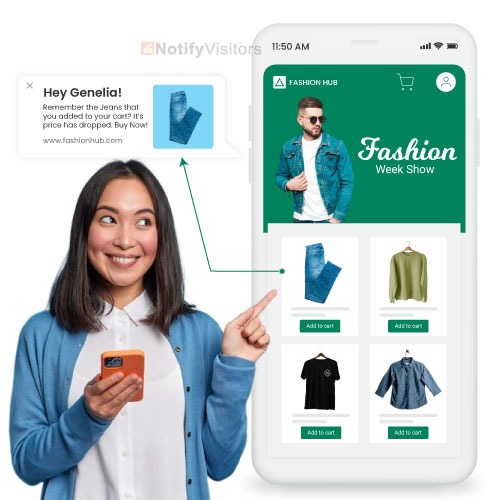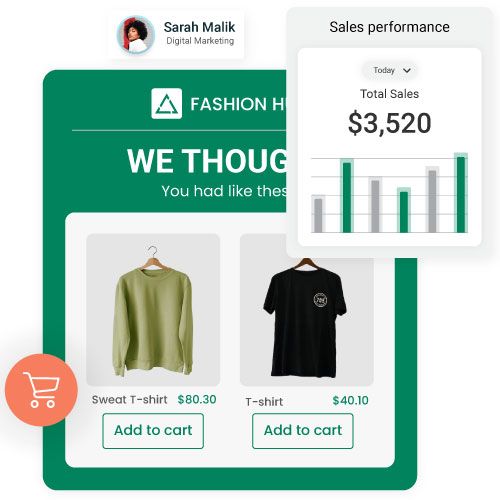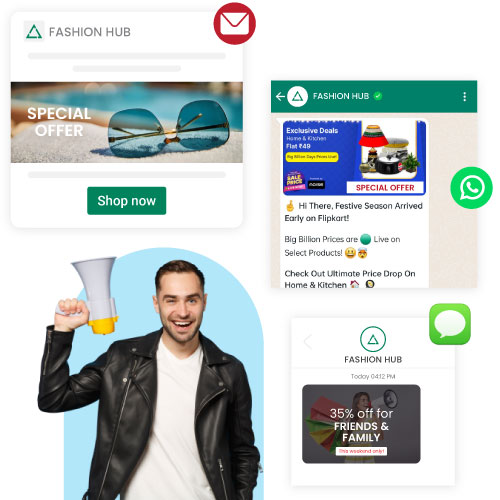In 2021, more than a quarter of the world’s population made at least one online transaction. By the time 2022 wraps up, estimates predict there will be 150 million more shoppers buying from online retailers.
Shipping delays, supply chain disruption, and labor shortages bolstered the already thriving eCommerce industry. Online shopping will continue encroaching on the retail world with a larger share. In 2025, eCommerce is set to top nearly 6.5 billion dollars in sales.
If you’re looking for a way to earn your piece of the pie by leveraging this growing trend – you are at the right place. In this article, we will help Shopify store owners boost eCommerce sales in 2025.
Contents
Why Choose Shopify for Your 2025 eCommerce Business?
Shopify is the leading US eCommerce platform. Research from late 2021 suggested that Shopify runs almost a third of eCommerce websites. For comparison, its main competitors – Wix, WooCommerce, and Squarespace – each had a market share of at least 11%.
Moreover, the eCommerce platform has over 2 million active daily users. In 2020 alone, the platform made over $2.9 billion in revenue. In the same year, 457 million people made at least one purchase on a Shopify-built website.
If stats didn’t make you a believer, perhaps the fact that brands such as Tesla, Sephora, and Nestlé all have online shops built on Shopify will.
13 Ways to Boost Your eCommerce Sales on Shopify
Now that you know why to run an online shop on Shopify, here are the best Shopify tips to keep on your radar.
1. Optimizing for Mobile Shopping

Mobile shopping accounts for three out of every four dollars spent on online sales. Thus, optimizing your website for mobile is the first step towards increasing your Shopify sales.
Most Shopify themes are responsive. This means they will resize to fit any device’s screen. Responsiveness ensures your eCommerce site will look great across platforms. Speed optimization can further enhance loading times, improve user experience, and boost search engine rankings.
Besides providing shoppers with a great UX, mobile-friendliness is vital for ranking well on Google. So, building an online store on Shopify is a wise choice to cut costs on site post-launch SEO.
Shopify also makes it easy to incorporate mobile-friendly design components into your website. For example, you can use a simple drag-and-drop option to add thumb-friendly buttons or a hamburger menu to your website.
Another proof of Shopify’s fantastic mobile experience is that 79% of visitors access its stores via a smartphone or tablet.
2. Livestream Shopping
Livestream shopping, a dynamic form of video streaming platform eCommerce, is rapidly gaining traction. Sellers leverage real-time video to showcase products, engage with audiences, and drive sales. Often featuring celebrities or influencers, live shopping has experienced explosive growth. Usually, live shopping involves celebrities and influencers presenting the goods to the audience.
A virtually non-existent industry only a few years back, live-stream shopping will, by 2024, hit $35 billion in the US alone.
So, it’s not surprising that major eCommerce platforms invest in integrating live shopping.
For its store owners, Shopify offers its native live-streaming tool called Live Shopping & Video Streams. The feature enables vendors to use video to sell, engage, and interact with consumers in real-time.
Moreover, Shopify’s live streaming plugin allows simultaneous multi-streaming on different platforms. In other words, Shopify site owners can stream their live events on Facebook, Twitch, and YouTube.
3. Website & Customer Analytics

Successful eCommerce digital marketing efforts are data-driven. Luckily, online shopping platforms like Shopify come with in-depth user analytics features.
Tracking and using this data can help your Shopify website across the board. Customer analytics is beneficial when redesigning your website, optimizing site products, and remarketing.
Some of the customer journey metrics to track using Shopify analytics are:
- Average order value
- Online store sessions by device type
- Online store sessions by location
- Online store sessions by traffic source
- Online store sessions from social sources
- Returning customer rate
- Top landing pages
- Top products by unit sold
- Total orders
- Total sales
- Sales attributed to marketing
4. Paying With Cryptocurrencies
Cryptocurrency is a growing desire for online shoppers. Data safety, fast transaction processing, and low fees are the top reasons for paying with crypto.
One of the first eCommerce platforms to enter the cryptocurrency sphere was Shopify. The eComm platform has allowed cryptocurrency payments since 2013.
Recently, Shopify announced partnerships with Strike and Crypto.com. Thus, the platform enabled payments with over 20 cryptocurrencies. These include Bitcoin, Ethereum, and Dogecoin.
5. Omnichannel Marketing

Omnichannel marketing strategy has been topping eCommerce marketing trends lists for the past few years. This digital marketing strategy entails the seamless integration of different customer-brand touchpoints.
As a consumer-centric tactic, omnichannel marketing creates a more impactful customer experience.
Omnichannel is a great marketing strategy for eCommerce shops. Primarily, it allows brands to cover all the channels people use to engage with, learn about, and communicate with online businesses.
Omnichannel marketing enables you to build a variety of touchpoints with potential customers. Build brand awareness or remarket to past shoppers by combining digital marketing techniques. Integrate diverse online marketing strategies into the omnichannel, including:
- Pay-per-click advertising
- Search engine optimization
- Content marketing
- Social media marketing
- Email marketing
For online shop owners, Shopify offers point-of-sale and eCommerce systems under one umbrella.
6. Shoppable Posts on Social Media

A 2022 report suggests that 130 million people tap on a shoppable post on Instagram every month. Shoppable social media postings shorten the buying journey for users. Thus, they help bring the users directly to the checkout.
Shopify allows Instagram and Facebook integration for a smooth shopping experience. For example, Shopify store owners can:
- Automatically sync product catalogs to Facebook and Instagram
- Sell products to Facebook and Instagram shoppers right on the platform
- Offer one-tap checkout without ever leaving Facebook or Instagram
Shopify’s integration with Facebook enables business owners to:
- Customize their Facebook shop to be on brand with the Shopify site
- Create collections of grouped items to allow customers to discover products
- Manage the shop across Instagram and Facebook from a single place
On Instagram, Shopify site owners can:
- Showcase your products in front of millions of potential shoppers worldwide
- Provide a smooth, consistent shopping journey experience
- Sell from a single inventory
- Create shoppable posts on Instagram.
7. Customer Experience Personalization
Personalization remains one of the essential eCommerce marketing trends. Grabbing the audience’s attention has become the top priority of online shops. And the best way to do so is by personalizing your content. In other words, provide your audience with an experience specific to them.
Your Shopify online store can offer a personalized customer experience through:
- Product recommendations
- Smart reviews
- User-generated content integration
- Personalized bestseller lists
- Immersive experiences via augmented reality and 3D images
- Smart sizing charts
- Automated messaging
- Retargeting based on behavioral triggers
8. Create a Custom Shopify Theme
Shopify allows website owners to customize their store’s theme. Yet, professional designers create most Shopify themes. So, it’s best to alter the theme as little as possible.
Focus your creative efforts on creating content to promote your products and consider outsourcing live chat to enhance customer engagement.
If you want to change your store’s layout, color scheme, and other design elements, hire qualified designers. You can consider digital marketing outsourced talent to find experienced and skillful people.
9. Leverage Different Product Media Types
Shopify’s product pages support diverse media types. Boost customer confidence in your products by presenting them via different media types. Showcase products in a variety of ways to improve the user experience and boost sales.
The eCommerce platform enables you to add media such as:
- Images
- Videos
- 3D models
Luckily for eCommerce owners, Shopify eliminates the hassle of optimizing these high-def media. For example, the platform automatically generates images of different sizes. This means that you don’t have to create images manually for diverse uses.
So, on the category page, Shopify will use the smaller, compact version of the image. And when a customer wishes to view a product in depth on the product page, they will see a larger, quality image.
Videos are a great way to grab your audience’s attention. Video marketing has become huge in retail, which relies on piquing user interest.
Studies show that video marketing can increase brand recognition by almost 150%. Besides, video content can boost conversion rates by over 80%.
In your Shopify store, upload videos that are both educational and interesting. Use video to provide more info on your products.
10. Improved Inventory Management
Customer expectations in the eCommerce industry depend on stock synchronicity. Thus, eCommerce companies need to track how products move through the system.
In 2025, businesses will have to combine their physical and digital assets. This ‘phygital’ experience will be the key to a better understanding of their online store’s inventory.
Luckily, Shopify allows sellers to have the next level of inventory visibility. The eComm platform’s inventory management feature prevents you from selling out-of-stock items. Moreover, it has integrated alerts to remind you to order necessary goods.
Besides, within Shopify’s Inventory section, you can:
- Set up inventory tracking
- Track your inventory
- Change your inventory levels
- Check the history of inventory edits
Deliver a top-notch customer experience by seeing and selling what is in stock.
11. Shopping with NFTs
Besides integrating cryptocurrencies, Spotify has also embraced trading Non-Fungible Tokens.
Shopify introduced NFT-gated storefronts as a new option for vendors. NFT integration is a great way to create stronger brand communities on the platform.
If you’re considering a platform for trading NFTs alongside cryptocurrencies, look into available analysis such as Kraken, Binance or MEXC review to help you understand how well it supports both assets in the evolving digital marketplace.
NFTs on Shopify can encourage communities to support brands by offering incentives. Moreover, online stores can promote products dedicated to company supporters.
12. Retargeting Ads
Advertising products through retargeting is another Shopify trend for 2025. The eCommerce platform offers display advertising for retargeting prospective customers.
Retargeting is a great way to reconnect with leads who have previously engaged with your products. Owners of Shopify websites can use cookies to retarget buyers across the web.
Use attractive visuals to make your retargeting ads more effective and persuade customers to convert.
Besides display ads, Shopify also allows you to create retargeting emails. Shopify email retargeting works identically to standard email marketing. Collect email addresses through your Shopify store and send an email to entice them to continue exploring your products.
But, ensure that your retargeting campaigns adhere to GDPR and other relevant data privacy laws. For example, collecting visitors’ emails or purchasing address bases goes against data policies. In addition, using emails for newsletters and retargeting without the user’s consent is illegal. Doing so could cause your company to face a serious lawsuit.
13. Search Engine Optimization

SEO is one of the most vital elements of digital marketing. Improving your website’s SEO helps increase organic visibility for your target search queries. Moreover, it helps improve the quality and quantity of traffic that comes to your shop.
Website optimization is key for top rankings in Google search results. Good site speed and bug-free code are some of the ways to get in Google’s favor.
SEO can also help you target customers across various stages of the sales funnel. Keyword-driven blog posts and quality backlinks are powerful ways to drive relevant customers to your shop.
As an eCommerce platform, Shopify has nailed all basic SEO elements. Shopify offers plenty of built-in features to help their online stores rank well in search engine results.
To Wrap Up
Shopify boasts some of the greatest technological innovations that will mark the retail industry in 2025. Live selling, social commerce, cryptocurrencies, and NFTs are the top eCommerce trends to follow.
Luckily, Shopify makes it easy for vendors to leverage all the state-of-the-art movements.
Besides staying on top of the latest eCommerce trends, Shopify covers all the online retail basics. The platform boasts many plugins, functionalities, and apps. All these allow shop owners to create, optimize, and promote their products and content.
Last but not least, Shopify includes a number of cross-platform integrations. This makes Shopify an all-in-one solution to market your brand and products to customers everywhere on the Internet.
Author bio
Travis Dillard is a business consultant and an organizational psychologist based in Arlington, Texas. Passionate about marketing, social networks, and business in general. In his spare time, he writes a lot about new business strategies and digital marketing for DigitalStrategyOne.

























 Email
Email SMS
SMS Whatsapp
Whatsapp Web Push
Web Push App Push
App Push Popups
Popups Channel A/B Testing
Channel A/B Testing  Control groups Analysis
Control groups Analysis Frequency Capping
Frequency Capping Funnel Analysis
Funnel Analysis Cohort Analysis
Cohort Analysis RFM Analysis
RFM Analysis Signup Forms
Signup Forms Surveys
Surveys NPS
NPS Landing pages personalization
Landing pages personalization  Website A/B Testing
Website A/B Testing  PWA/TWA
PWA/TWA Heatmaps
Heatmaps Session Recording
Session Recording Wix
Wix Shopify
Shopify Magento
Magento Woocommerce
Woocommerce eCommerce D2C
eCommerce D2C  Mutual Funds
Mutual Funds Insurance
Insurance Lending
Lending  Recipes
Recipes  Product Updates
Product Updates App Marketplace
App Marketplace Academy
Academy

